![[OpenVMS documentation]](../../images/openvms_doc_banner_top.gif)
|
![[Site home]](../../images/buttons/bn_site_home_off.gif)
![[Send comments]](../../images/buttons/bn_comments_off.gif)
![[Help with this site]](../../images/buttons/bn_site_help_off.gif)
![[How to order documentation]](../../images/buttons/bn_order_docs_off.gif)
![[OpenVMS site]](../../images/buttons/bn_openvms_off.gif)
![[Compaq site]](../../images/buttons/bn_compaq_off.gif)
|
|
Updated:
11 December 1998
|
Guide to OpenVMS File Applications
10.1.3 Using Interactive Mode
The /INTERACTIVE qualifier begins an interactive session in which you
can examine the structure of an RMS file.
ANALYZE/RMS_FILE imposes a hierarchical tree structure on the internal
RMS
file structure. Each data structure in the file is a node, with a
branch for each pointer in the data structure. The file header is
always the root node. Each of the three file organizations (sequential,
relative, and indexed) has its own tree structure.
To examine a file, you enter commands that move the current position to
particular structures within the tree. The utility displays the current
structure on the screen.
Table 10-1 summarizes the ANALYZE/RMS_FILE commands.
Table 10-1 ANALYZE/RMS_FILE Command Summary
| Command |
Function |
|
AGAIN
|
Displays the current structure again.
|
|
DOWN [branch]
|
Moves the structure pointer down to the next level. If the current node
has more than one branch, the branch keyword must be specified.
If a branch keyword is required but not specified, the utility will
display a list of possibilities to prompt you. You can also display the
list by specifying "DOWN ?."
|
|
DUMP n
|
Displays a hexadecimal dump of the specified block.
|
|
EXIT
|
Ends the interactive session.
|
|
FIRST
|
Moves the structure pointer to the first structure on the current
level. The structure is displayed. For example, if you are examining
data buckets and want to examine the first bucket, this command will
put you there and display the first bucket's header.
|
|
HELP [keyword ...]
|
Displays help messages about the interactive commands.
|
|
NEXT
|
Moves the structure pointer to the next structure on the current level.
The structure is displayed.
Pressing the Return key is equivalent to a NEXT command.
|
|
REST
|
Moves the structure pointer along the rest of the structures on the
current level, and each is displayed in turn.
|
|
TOP
|
Moves the structure pointer up to the file header. The file header is
displayed.
|
|
UP
|
Moves the structure pointer up to the next level. The structure at that
level is displayed.
|
10.1.4 Examining a Sequential File
Figure 10-1 shows the tree structure of a sequential file.
Figure 10-1 Tree Structure for Sequential Files
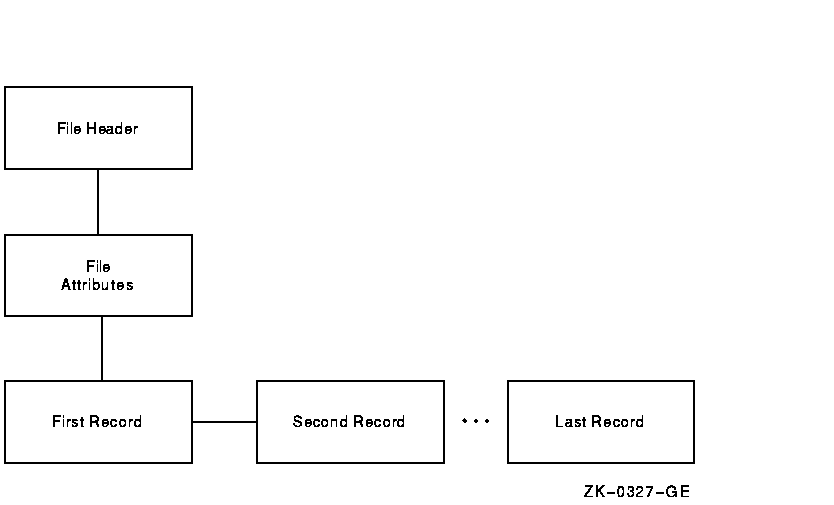
The FILE HEADER structure is always the first structure displayed. From
the FILE HEADER structure, the DOWN command moves the current position
to the FILE ATTRIBUTES structure. The DOWN command from the FILE
ATTRIBUTES structure moves the current position to the first record in
the file. From the first record, the REST command will move the current
position through the records in the file, displaying each one in turn.
A series of NEXT commands will also accomplish this same operation.
Figure 10-2 shows the layout and contents of the records in a
sequential file SEQ.DAT. Example 10-3 is an interactive examination of
SEQ.DAT, showing the contents of three records in the file.
Figure 10-2 Record Layout and Content for SEQ.DAT

| Example 10-3 Examining a Sequential File |
$ ANALYZE/RMS_FILE/INTERACTIVE SEQ.DAT
|
FILE HEADER
File Spec: DISK$DELPHIWORK:[RMS32]SEQ.DAT;3
File ID: (1170,2,2)
Owner UIC: [730,465]
Protection: System: RWED, Owner: RWED, Group: RWED, World:
Creation Date: 7-MAY-1993 16:51:30.92
Revision Date: 8-MAY-1993 14:02:17.15, Number: 3
Expiration Date: none specified
Backup Date: none posted
Contiguity Options: none
Performance Options: none
Reliability Options: none
|
RMS FILE ATTRIBUTES
File Organization: sequential
Record Format: variable
Record Attributes: carriage-return
Maximum Record Size: 0
Longest Record: 73
Blocks Allocated: 3, Default Extend Size: 0
End-of-File VBN: 1, Offset: %X'00E4'
File Monitoring: disabled
Global Buffer Count: 0
|
DATA BYTES (VBN 1, offset %X'0000'):
7 6 5 4 3 2 1 0 01234567
------------------------ --------
31 30 30 30 30 30 00 49| 0000 |I.000001|
20 4C 41 54 49 47 49 44| 0008 |DIGITAL |
4E 45 4D 50 49 55 51 45| 0010 |EQUIPMEN|
52 4F 50 52 4F 43 20 54| 0018 |T CORPOR|
31 31 20 4E 4F 49 54 41| 0020 |ATION 11|
42 20 54 49 50 53 20 30| 0028 |0 SPIT B|
41 4F 52 20 4B 4F 4F 52| 0030 |ROOK ROA|
41 55 48 53 41 4E 20 44| 0038 |D NASHUA|
33 30 48 4E 20 20 20 20| 0040 | NH03|
00 31 36 30| 0048 |062. |
|
DATA BYTES (VBN 1, offset %X'004C'):
7 6 5 4 3 2 1 0 01234567
------------------------ --------
32 30 30 30 30 30 00 49| 0000 |I.000002|
49 46 46 4F 20 42 44 41| 0008 |ADB OFFI|
4C 50 50 55 53 20 45 43| 0010 |CE SUPPL|
20 20 20 20 20 53 45 49| 0018 |IES |
32 34 20 20 20 20 20 20| 0020 | 42|
4F 4D 45 53 4F 52 20 30| 0028 |0 ROSEMO|
45 52 54 53 20 54 4E 55| 0030 |UNT STRE|
49 44 20 4E 41 53 54 45| 0038 |ETSAN DI|
32 39 41 43 20 4F 47 45| 0040 |EGO CA92|
00 30 31 31| 0048 |110. |
|
DATA BYTES (VBN 1, offset %X'0098'):
7 6 5 4 3 2 1 0 01234567
------------------------ --------
33 30 30 30 30 30 00 49| 0000 |I.000003|
52 50 20 52 4F 4C 4F 43| 0008 |COLOR PR|
4C 20 47 4E 49 54 4E 49| 0010 |INTING L|
52 4F 54 41 52 4F 42 41| 0018 |ABORATOR|
34 39 20 20 20 53 45 49| 0020 |IES 94|
35 20 54 53 41 45 20 39| 0028 |9 EAST 5|
45 45 52 54 53 20 48 54| 0030 |TH STREE|
4F 59 20 57 45 4E 20 54| 0038 |T NEW YO|
30 31 59 4E 20 20 4B 52| 0040 |RK NY10|
00 33 30 30| 0048 |003. |
|
10.1.5 Examining a Relative File
Figure 10-3 shows the tree structure of relative files.
Figure 10-3 Tree Structure of Relative Files
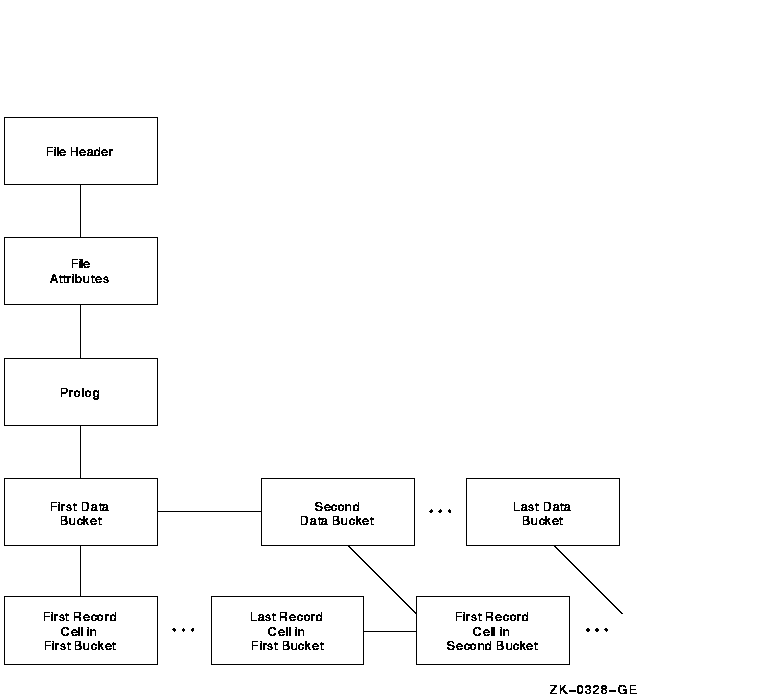
The tree structure of relative files also begins with the FILE HEADER
and FILE ATTRIBUTES structures. From the FILE ATTRIBUTES structure, the
next structure down is the PROLOG. The first structure down from the
PROLOG is the FIRST DATA BUCKET. The data bucket structures can be
examined with the REST command or one at a time with the NEXT command.
The only information at the data bucket level is the number of the data
bucket's virtual block.
The next structure down is the FIRST RECORD CELL IN FIRST BUCKET. You
can examine the records in each cell by specifying either the REST
command or a series of NEXT commands.
Example 10-4 shows an interactive examination of a relative file.
| Example 10-4 Examining a Relative File |
FILE HEADER
File Spec: DISK$NEWWORK:[RMS32]REL.DAT;1
File ID: (9573,7,2)
Owner UIC: [181,065]
Protection: System: RWED, Owner: RWED, Group: RE, World:
Creation Date: 22-MAY-1993 10:42:04.95
Revision Date: 22-MAY-1993 10:42:05.81, Number: 1
Expiration Date: none specified
Backup Date: none posted
Contiguity Options: contiguous-best-try
Performance Options: none
Reliability Options: none
|
RMS FILE ATTRIBUTES
File Organization: relative
Record Format: variable
Record Attributes: carriage-return
Maximum Record Size: 75
Blocks Allocated: 9, Default Extend Size: 0
Bucket Size: 3
File Monitoring: disabled
Global Buffer Count: 0
|
FIXED PROLOG
Prolog Flags:
(0) PLG$V_NOEXTEND 0
First Data Bucket VBN: 2
Maximum Record Number: 2147483647
End-of-File VBN: 10
Prolog Version: 1
|
RECORD CELL (VBN 2, offset %X'0000'):
Cell Control Flags:
(2) DLC$V_DELETED 0
(3) DCL$V_REC 1
Record Bytes:
7 6 5 4 3 2 1 0 01234567
------------------------ --------
31 30 30 30 30 30 00 49| 0000 |I.000001|
20 4C 41 54 49 47 49 44| 0008 |DIGITAL |
4E 45 4D 50 49 55 51 45| 0010 |EQUIPMEN|
52 4F 50 52 4F 43 20 54| 0018 |T CORPOR|
31 31 20 4E 4F 49 54 41| 0020 |ATION 11|
42 20 54 49 50 53 20 30| 0028 |0 SPIT B|
41 4F 52 20 4B 4F 4F 52| 0030 |ROOK ROA|
41 55 48 53 41 4E 20 44| 0038 |D NASHUA|
33 30 48 4E 20 20 20 20| 0040 | NH03|
31 36 30| 0048 |062 |
|
If you use the REST command at the CELL AND RECORD level, the utility
will display all the cells and records in the file, not just the cells
and records in the current bucket.
10.1.6 Examining an Indexed File
The structure of an indexed file also begins with the FILE HEADER, FILE
ATTRIBUTES, and PROLOG structures. From the PROLOG structure, the file
structure branches to the area descriptors and the key descriptors. To
branch to the area descriptor path, specify the command DOWN AREA. To
branch to the key descriptor path, specify DOWN KEY.
The area descriptor path contains structures that show information
about the various areas in the file. The key descriptor path contains
the primary key structures (and data records) and any secondary key
structures.
Figure 10-4 shows the structure following the area descriptor path.
Figure 10-4 Area Descriptor Path
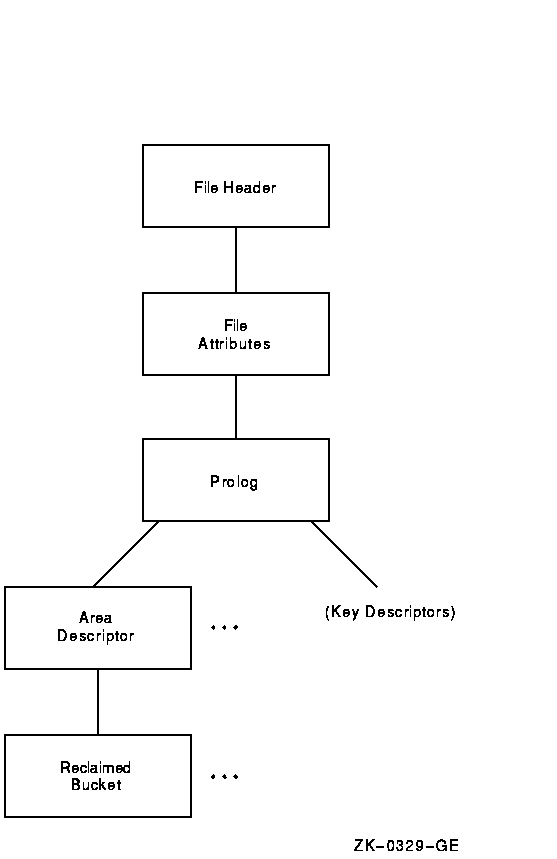
Example 10-5 shows an examination of an area descriptor path from the
PROLOG level.
| Example 10-5 Examining an Area Descriptor
Path |
AREA DESCRIPTOR #0 (VBN 3, offset %X'0000'))
Bucket Size: 1)
Alignment: AREA$C_NONE)
Alignment Flags:)
(0) AREA$V_HARD 0)
(1) AREA$V_ONC 0)
(5) AREA$V_CBT 0)
(7) AREA$V_CTG 0)
Current Extent Start: 1, Blocks: 9, Used: 7, Next: 8)
Default Extend Quantity: 0)
|
Figure 10-5 shows the structure following the key descriptor path. As
shown in the figure, you can branch directly to the DATA BUCKET, or you
can branch to the INDEX ROOT BUCKET to begin examination of the index
structure, eventually reaching the DATA BUCKET structure.
Depending on whether you are examining the primary index structure or
one of the alternate index structures, there is a difference in the
contents of the record structure.
The PRIMARY RECORD structure contains the actual data records; the
ALTERNATE RECORD structures contain secondary index data records
(SIDRs).
Figure 10-5 Key Descriptor Path
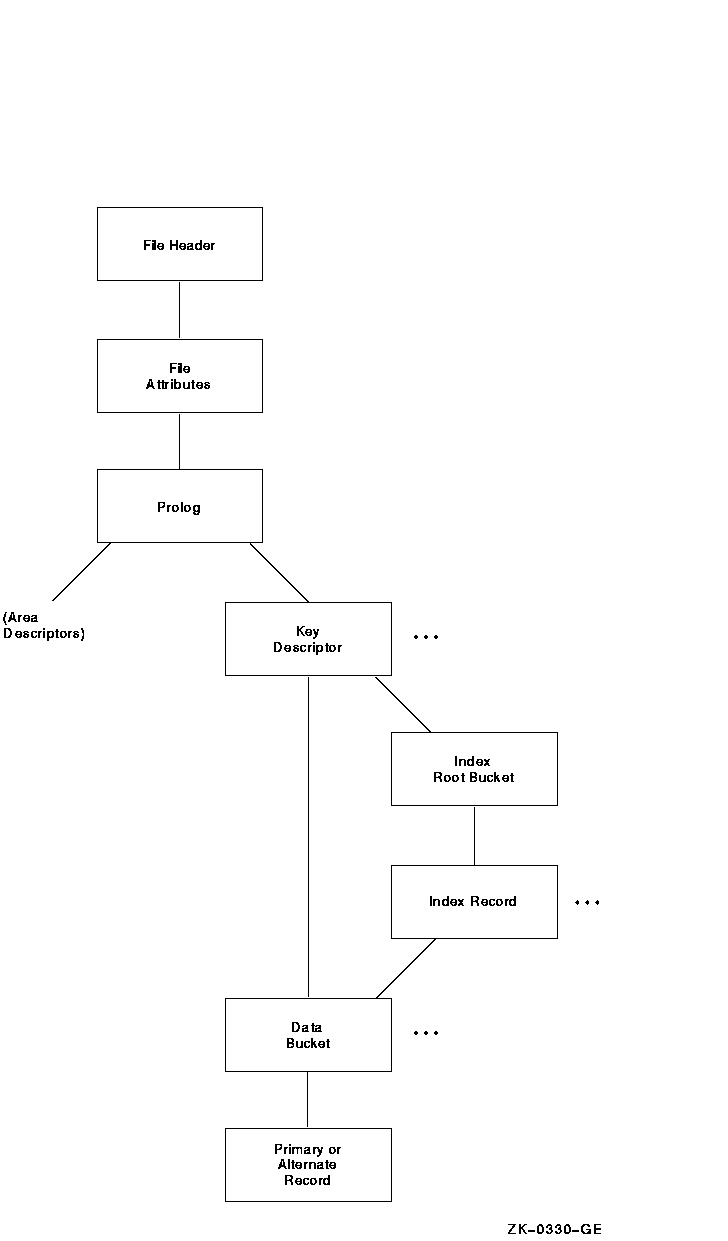
Figure 10-6 displays the structure of the primary records.
Figure 10-6 Structure of Primary Records
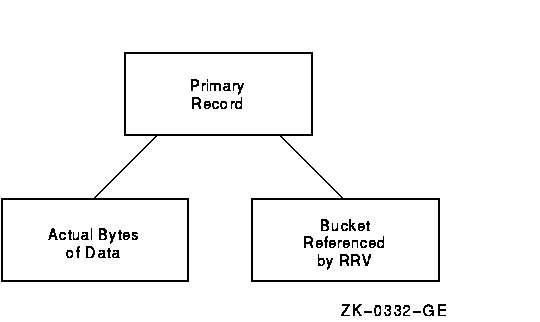 As shown in Figure 10-6, the branch from the primary record structure
allows you to either examine the actual bytes of data within the record
or to follow the RRV.
As shown in Figure 10-6, the branch from the primary record structure
allows you to either examine the actual bytes of data within the record
or to follow the RRV.
Example 10-6 shows an examination of a primary record.
| Example 10-6 Examining a Primary Record |
PRIMARY DATA RECORD (VBN 4, offset %X'000E')
Record Control Flags:
(2) IRC$V_DELETED 0
(3) IRC$V_RRV 0
(4) IRC$V_NOPTRSZ 0
Record ID: 1
RRV ID: 1, 4-Byte Bucket Pointer: 4
Key:
7 6 5 4 3 2 1 0 01234567
------------------------ --------
31 30 30 30 30 30| 0000 |000001 |
|
7 6 5 4 3 2 1 0 01234567
------------------------ --------
31 30 30 30 30 30 00 49| 0000 |I.000001|
20 4C 41 54 49 47 49 44| 0008 |DIGITAL |
4E 45 4D 50 49 55 51 45| 0010 |EQUIPMEN|
52 4F 50 52 4F 43 20 54| 0018 |T CORPOR|
31 31 20 4E 4F 49 54 41| 0020 |ATION 11|
42 20 54 49 50 53 20 30| 0028 |0 SPIT B|
41 4F 52 20 4B 4F 4F 52| 0030 |ROOK ROA|
41 55 48 53 41 4E 20 44| 0038 |D NASHUA|
33 30 48 4E 20 20 20 20| 0040 | NH03|
31 36 30| 0048 |062 |
|
PRIMARY DATA RECORD (VBN 4, offset %X'000E')
Record Control Flags:
(2) IRC$V_DELETED 0
(3) IRC$V_RRV 0
(4) IRC$V_NOPTRSZ 0
Record ID: 1
RRV ID: 1, 4-Byte Bucket Pointer: 4
Key:
7 6 5 4 3 2 1 0 01234567
------------------------ --------
31 30 30 30 30 30| 0000 |000001 |
|
BUCKET HEADER (VBN 4)
Check Character: %X'00'
Area Number: 0
VBN Sample: 4
Free Space Offset: %X'0104'
Free Record ID Range: 4 - 255
Next Bucket VBN: 4
Level: 0
Bucket Header Flags:
(0) BKT$V_LASTBKT 1
(1) BKT$V_ROOTBKT 0
|
Figure 10-7 displays the structure of the alternate records.
Figure 10-7 Structure of Alternate Records
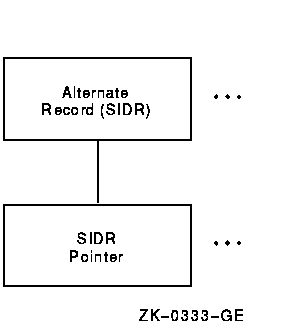
Example 10-7 shows an examination of an alternate record.
| Example 10-7 Examining an Alternate
Record |
SIDR RECORD (VBN 6, offset %X'000E')
Control Flags:
(4) IRC$V_NOPTRSZ 0
Record ID: 1
Key:
7 6 5 4 3 2 1 0 01234567
------------------------ --------
31 36 30 33 30| 0000 |03062 |
|
sidr pointer control flags:
(2) IRC$V_DELETED 0
(5) IRC$V_KEYDELETE 0
sidr pointer record id: 1, 4-byte record VBN: 4
|
10.2 Generating an FDL File from a Data File
You can use the Analyze/RMS_File utility to create an FDL file
generally called an analysis file. FDL files created by
ANALYZE/RMS_FILE contain statistics about each area and key in the
primary sections named ANALYSIS_OF_AREA and ANALYSIS_OF_KEY.
These analysis sections are then used by the Edit/FDL utility in its
Optimize script. You can compare the statistics in these sections with
your assumptions about the file's use; you may find some places in the
file's structure where additional tuning will be possible.
To generate an FDL file from a data file, use the following command
syntax:
ANALYZE/RMS_FILE/FDL filespec
|
With a command of this type, the FDL file obtains its file name from
the input file specification; to assign a different file name, use the
/OUTPUT qualifier. For example, the following command would generate an
FDL file named INDEXDEF.FDL from the data file CUSTFILE.DAT:
$ ANALYZE/RMS_FILE/FDL/OUTPUT=INDEXDEF CUSTFILE.DAT
|
Example 10-8 shows an FDL file showing the KEY and ANALYSIS_OF_KEY
sections for an indexed file with two keys.
| Example 10-8 KEY and ANALYSIS_OF_KEY Sections
in an FDL File |
IDENT 2-JUN-1993 16:15:35 VMS ANALYZE/RMS_FILE Utility
SYSTEM
SOURCE VMS
FILE
ALLOCATION 9
BEST_TRY_CONTIGUOUS no
BUCKET_SIZE 1
CONTIGUOUS no
EXTENSION 0
GLOBAL_BUFFER_COUNT 0
NAME DISK$USERWORK:[WORK.RMS32]CUSTDATA.DAT;4
ORGANIZATION indexed
OWNER [520,50]
PROTECTION (system:RWED, owner:RWED, group:RWED, world:)
READ_CHECK no
WRITE_CHECK no
RECORD
BLOCK_SPAN yes
CARRIAGE_CONTROL carriage_return
FORMAT variable
SIZE 0
AREA 0
BEST_TRY_CONTIGUOUS no
BUCKET_SIZE 1
CONTIGUOUS no
EXTENSION 0
KEY 0
CHANGES no
DATA_AREA 0
DATA_FILL 100
DUPLICATES no
INDEX_AREA 0
INDEX_FILL 100
LEVEL1_INDEX_AREA 0
NULL_KEY no
PROLOG 1
SEG0_LENGTH 6
SEG0_POSITION 0
TYPE string
KEY 1
CHANGES no
DATA_AREA 0
DATA_FILL 100
DUPLICATES yes
INDEX_AREA 0
INDEX_FILL 100
LEVEL1_INDEX_AREA 0
NULL_KEY no
SEG0_LENGTH 5
SEG0_POSITION 68
TYPE string
ANALYSIS_OF_AREA 0
RECLAIMED_SPACE 0
ANALYSIS_OF_KEY 0
DATA_FILL 50
DATA_RECORD_COUNT 3
DATA_SPACE_OCCUPIED 1
DEPTH 1
INDEX_FILL 4
INDEX_SPACE_OCCUPIED 1
MEAN_DATA_LENGTH 73
MEAN_INDEX_LENGTH 9
ANALYSIS_OF_KEY 1
DATA_FILL 14
DATA_RECORD_COUNT 3
DATA_SPACE_OCCUPIED 1
DEPTH 1
DUPLICATES_PER_SIDR 1
INDEX_FILL 4
INDEX_SPACE_OCCUPIED 1
MEAN_DATA_LENGTH 19
MEAN_INDEX_LENGTH 8
|
![[OpenVMS documentation]](../../images/openvms_doc_banner_top.gif)
![[Site home]](../../images/buttons/bn_site_home_off.gif)
![[Send comments]](../../images/buttons/bn_comments_off.gif)
![[Help with this site]](../../images/buttons/bn_site_help_off.gif)
![[How to order documentation]](../../images/buttons/bn_order_docs_off.gif)
![[OpenVMS site]](../../images/buttons/bn_openvms_off.gif)
![[Compaq site]](../../images/buttons/bn_compaq_off.gif)
![[OpenVMS documentation]](../../images/openvms_doc_banner_top.gif)
![[Site home]](../../images/buttons/bn_site_home_off.gif)
![[Send comments]](../../images/buttons/bn_comments_off.gif)
![[Help with this site]](../../images/buttons/bn_site_help_off.gif)
![[How to order documentation]](../../images/buttons/bn_order_docs_off.gif)
![[OpenVMS site]](../../images/buttons/bn_openvms_off.gif)
![[Compaq site]](../../images/buttons/bn_compaq_off.gif)





 As shown in Figure 10-6, the branch from the primary record structure
allows you to either examine the actual bytes of data within the record
or to follow the RRV.
As shown in Figure 10-6, the branch from the primary record structure
allows you to either examine the actual bytes of data within the record
or to follow the RRV.

![[Site home]](../../images/buttons/bn_site_home_off.gif)
![[Send comments]](../../images/buttons/bn_comments_off.gif)
![[Help with this site]](../../images/buttons/bn_site_help_off.gif)
![[How to order documentation]](../../images/buttons/bn_order_docs_off.gif)
![[OpenVMS site]](../../images/buttons/bn_openvms_off.gif)
![[Compaq site]](../../images/buttons/bn_compaq_off.gif)
![[OpenVMS documentation]](../../images/openvms_doc_banner_bottom.gif)